ASUS P8Z77-V Premium Review: A Bentley Among Motherboards
by Ian Cutress on August 13, 2012 10:30 AM EST- Posted in
- Motherboards
- Asus
- Z77
USB Speed
For this benchmark, we run CrystalDiskMark to determine the ideal sequential read and write speeds for the USB port using our 240 GB OCZ Vertex3 SSD with a SATA 6 Gbps to USB 3.0 converter. Then we transfer a set size of files from the SSD to the USB drive using DiskBench, which monitors the time taken to transfer. The files transferred are a 1.52 GB set of 2867 files across 320 folders – 95% of these files are small typical website files, and the rest (90% of the size) are the videos used in the Sorenson Squeeze test.
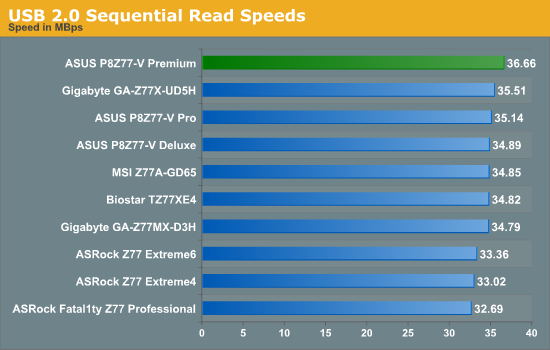
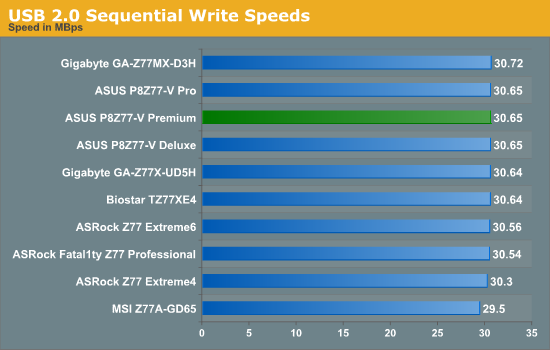
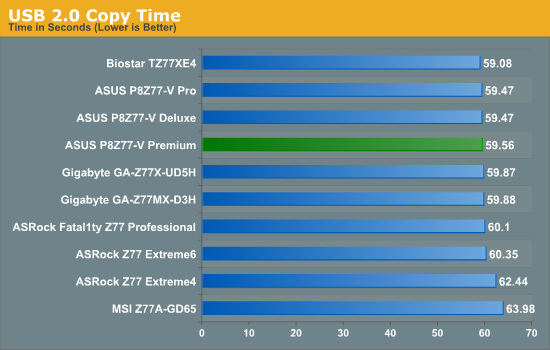
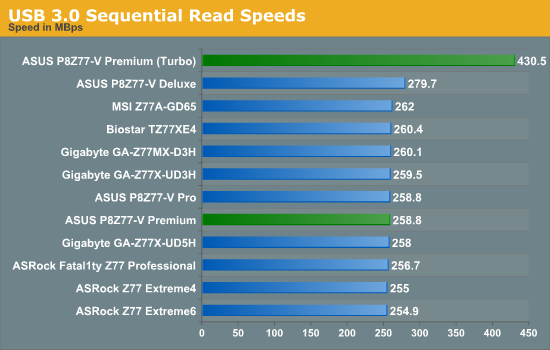
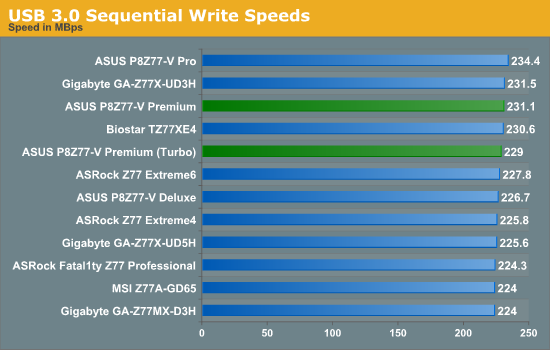
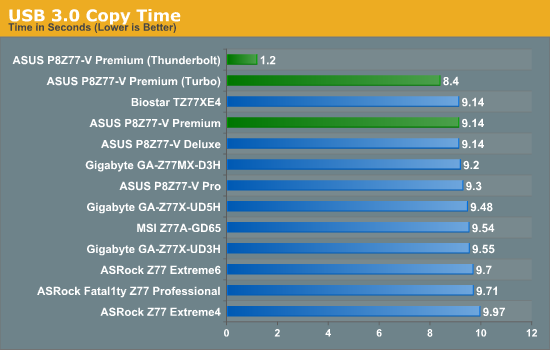
Our chipset USB testing shows the Premium in the top half of each of our graphs. Of particular note is the USB 3.0 copy test, where the Premium equals our best native USB 3.0 copy timings, and using ASUS' enhanced Turbo option on the native USB 3.0, we achieve even better performance. When attached to the ASMedia controller under UASP, the ASUS P8Z77-V Premium performs better than any other motherboard's default solution.
Also of note is our Thunderbolt result for our copy test, which comes in at 1.20 seconds. This result was erratic, sometimes going to three seconds or above. When we come to testing more Thunderbolt motherboards, we have a different copy test to probe differences between the implementations.
SATA Testing
We also use CrystalDiskMark for SATA port testing on a C300 drive. The sequential test (incompressible data) is run at the 5 x 1000 MB level. This test probes the efficiency of the data delivery system between the chipset and the drive, or in the case of additional SATA ports provided by a third party controller, the efficiency between the controller, the chipset and the drive.

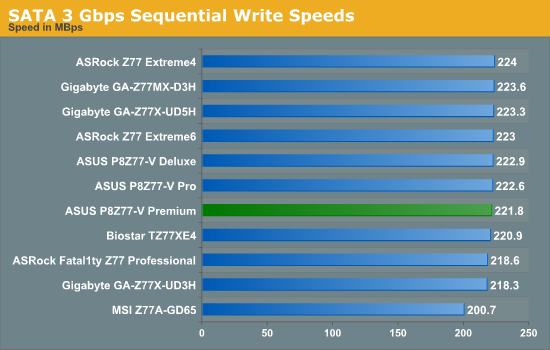
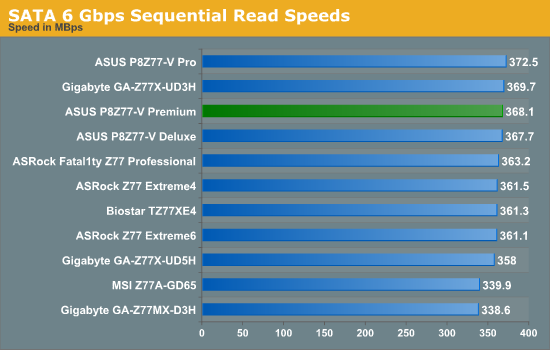
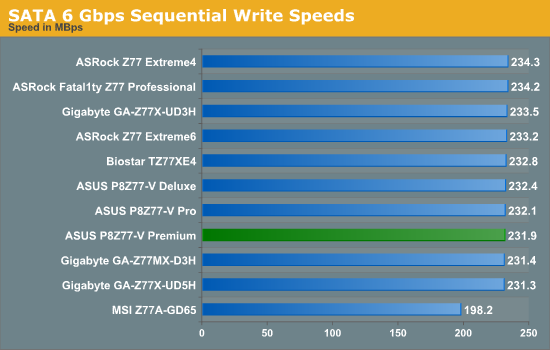
DPC Latency
Deferred Procedure Call latency is a way in which Windows handles interrupt servicing. In order to wait for a processor to acknowledge the request, the system will queue all interrupt requests by priority. Critical interrupts will be handled as soon as possible, whereas lesser priority requests, such as audio, will be further down the line. So if the audio device requires data, it will have to wait until the request is processed before the buffer is filled. If the device drivers of higher priority components in a system are poorly implemented, this can cause delays in request scheduling and process time, resulting in an empty audio buffer – this leads to characteristic audible pauses, pops and clicks. Having a bigger buffer and correctly implemented system drivers obviously helps in this regard. The DPC latency checker measures how much time is processing DPCs from driver invocation – the lower the value will result in better audio transfer at smaller buffer sizes. Results are measured in microseconds and taken as the peak latency while cycling through a series of short HD videos - under 500 microseconds usually gets the green light, but the lower the better.

Surprisingly our ASUS P8Z77-V Premium DPC test comes in at one of the highest Z77 motherboard results, double the 60 microseconds of the ASUS P8Z77-V Pro. However, the result is still under 200 microseconds, which gives it an excellent rating.










43 Comments
View All Comments
ptrinh1979 - Tuesday, August 14, 2012 - link
I was confused as well, but in my case, I can use this to offload the pagefile without sacrificing a drive bay in my chassis.BytesMage - Tuesday, September 11, 2012 - link
Page file is good for this. Planning on raiding 2 SSDs in raid 0 on Intel then SSD cache ll on the marvel with 2 60gb SSDs to 3tb HDD. I was wondering what to do with the 32gb mSata.ASUSTechMKT - Tuesday, August 14, 2012 - link
The 32GB mSATA was integrated to allow for quick access to utilizing Intel SSD Caching functionality. While many users are adopting high performance SSDs the cost of higher capacities is till high and in addition limited. Mechanical drives still considerably outpace and outsell SSDs in integration in all price points of desktops. Having this 32GB drive integrated easily allows for you to "SSD Cache a 2, 3 or 4TB drive" this allows you to have a much smoother and quicker response experience from the mechanical volume.While not noted the setup has also been streamlined in our utility to allow for a quick one click level of initialization for Intel SSD Caching or ASUS SSD Caching from the Marvell controller.
Rick83 - Monday, August 13, 2012 - link
At this price point, that is fairly ridiculous.So yes, there is "Thunderbolt", but a Firewire 800 Controller would probably be more useful, as there are way more Firewire devices in the wild than Thunderbolt.
Not sure how much the 82579V really can be called "server grade" either.
The 82579V on the Gene-Z shouldn't be all that different, having the same designation, but you have to manually hack the .inf to get the driver to install on Windows server. Not sure what makes this one server grade, seeing as the broken .inf comes directly from Intel.
Checking the other NIC, that one is more likely to be server grade, it costs almost twice as much. Not sure who made that mix-up.
IanCutress - Monday, August 13, 2012 - link
This was my error. The 82583 is not server grade, but as a helpful reader pointed out via email, the 82571, 82572, 82574, 82576, 82580 and I350 are. Super helpful naming scheme to tell them apart... :)Ian
Googer - Monday, August 13, 2012 - link
Thunderbolt is capable if mimicking firewire and just about every other IO technology in existence. So there is no real need for the added PCB Real Estate or monetary expense of a 1394 chip when 1394b is something that never really caught on (SAD).bigboxes - Tuesday, August 14, 2012 - link
Give up on the firewire. It's got USB 3.0. & USB 2.0. Anything you might need beyond that will either be Thunderbolt or some future USB 4.0. I've never needed Firewire. I've wasted money on a Firewire card, but that's not the same thing as needing it, now is it?Rick83 - Tuesday, August 14, 2012 - link
There's a lot of Firewire Video stuff (I'm following the IEEE1394-Linux mailing list, and there is still development and occasional use in a variety of contexts) Also I have a FireWire CF-reader. Not to mention that it's still much cheaper than TB, and in the shape of FW-800 still bloody fast, thanks to physical DMA.Also, at 450 euro, there's just no reason not to mark that check-box. Thunderbird is NOT a drop-in replacement. It's not like there's no space left on the back plane.
I actually had a look at the P8C WS yesterday evening, and it seems that that board is what this board should be, at half the price.
Two server grade NICs, FireWire, DVI out, support for ECC MEM and Xeons.
No WiFi, Thunderbolt, SSD or PLX though, but then those are probably less useful to (me and) most people, than the aforementioned.
Oh and it has 4x SATA less. But then 10x SATA is what my much cheaper GigaByte P55-UD5 has, and had years ago (Yes, they're all in use - Yes I'm looking at the WS because I've been having issues (kernel panics, NICs misbehaving) with it lately and server NICs and ECC probably are a good idea after all)
BoloMKXXVIII - Monday, August 13, 2012 - link
I have to agree with others who are a bit confused why a 32 GB SSD was included. As for the rest of the board, I will keep an eye out for when this board starts dropping in price. It is bound to happen. As long as it doesn't take too long it could fit well into my near future plans.Kristian Vättö - Monday, August 13, 2012 - link
Any idea how the Marvell 9230 SATA 6Gbps controller performs? Marvell's previous controllers haven't been too great, so I'm curious to know if the 9230 is any better.